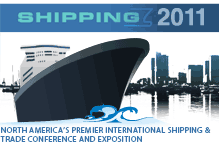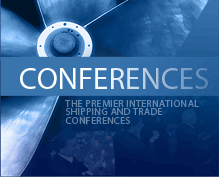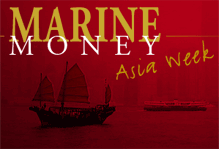
Editor: Transparency Makes Better Shipping
For certain it has been a sobering year for shipping markets and for the whole world. The confluence of events that really started with the beginning of the recession in the US, highlighted by the travesty of September 11th and punctuated by the “War on Terror”, Enron, the analyst fiasco and even shipping share ACLN (the first forcibly de-listed NYSE company in 27 years), has made the whole appearance and feel of the world completely different. One of the better offshoots of the financial/business headaches is the growth in importance of transparency in the shipping business.
The day this note is being written NIB Capital in the Hague acknowledged that it was securitizing $670m in shipping debt in five classes rated from S&P AA+ to BBB. Yes they have some investment grade debt! Marketing started on June 6th and is to target non- shipping institutional investors in collateralized debt. NIB notes that the move is to diversify risk so that it can grow its $2 billion shipping book further with the $670m constituting about 5-6% of the total credit portfolio of the entire bank. This Editor finds it a very positive move for any bank to do such and the hardest thing in the process was likely structuring the deal so that the rating agencies would even look at it. Not that the loans were or are bad, but the process must have been grueling. Continue Reading
Balancing Act? No Worries.
The US is the lynchpin of the world economy. On May 7th 2002 the US Labor Department reported that US worker productivity improved at a rate of 8.6%/year which further dampened the nearly nonexistent inflation concerns. There certainly is liquidity in the US, just look at the rising real estate markets, renewed interest in the bond market, the interest in dividend yields and the spike in share values after the somewhat positive Cisco Systems Q1 2002 earnings report. On the other hand, the lack of inflation is really disinflation bordering on deflation with margins so thin that investment is not an option for many companies. This has lead to the highest unemployment rate in the country, over 6%, since 1993. Therefore the Federal Reserve has left US interest Rates stable, the outlook neutral and the “loose dollar” rules. It is a balancing act, quite simply, and today its still unknown whether the US is in recovery or not. Continue Reading
Oil Production and Tanker Rates
The preceding article is oddly comforting. Its highly unlikely that the system supporting the oil supply/demand dynamic will change radically in the near term because the regimes of the OPEC 10 all rely on the stability of the income to maintain their regimes. Yes the dynamic of increased Russian production and the political turmoil we now face does impact the equation, but the fact that most of the region; while a portion of the populace resents the cultural implications of such and is on this tyrannical tact today; is better off maintaining this economic relationship with the West, not going to war over it.
The target range for the OPEC basket, now about $22-27/bbl, has little or nothing to do with optimizing profit and a lot to do with poli-economic survival. If the price drops too low, services for the populace of the producer states suffer and coups become a distinct possibility; too high and the consumer nations will activate their idle wells, of which there are plenty, then seek alternative sources and finally work even harder on alternative fuels.
The oslo 8: OSE Shipping Equity Values
Since Stelmar successfully completed its IPO in New York last spring a lot of the focus on the public shipping sector has moved in the same direction. Since then even more companies have raised capital in New York either through IPOs or a secondary/ADR listing. The Athens Stock Exchange is still not open to shipping companies under a set of rules shipowners are happy with, Copenhagen is as silent as ever, and the same can be said for Stockholm, London, Amsterdam, and Milan. In Asia there is only small interest with sporadic activity.
So what about Oslo? Has the “World’s Shipping Bourse” lost all its glory and is now only an underpriced, illiquid disaster waiting to happen? We think not. There are still shipping companies worth nearly $5 billion listed in Oslo and although there have been no new IPOs or significant secondary listings for years it would be wrong to disregard it completely. There is still a good mix of non- tanker shipping companies that we feel is worth a second look.
On the coming pages we have taken a sharp look at 8 companies listed in Norway. We will give you a brief description of their current valuations and give a few hints of what should or should not be done to help bring foreign institutional investors back to Oslo.
The TCE Calculation Conundrum
On every public tanker earnings release, one sees an endless reference to the Time Charter Equivalent rate (TCE) as a measure of earnings results. However, it is rarely defined and, even if it is, one com pany is not necessarily going to calculate it in the same manner as another. Hence, as a measure, it is equivalent to each of the many television meteorologists utilizing a different measure for the outdoor temperature; everyone would understand the goal of the reading but no one would have anything to benchmark the reading against.
We are not saying that companies are being dishonest whatsoever. In fact we applaud the effort to use the device but there are many ways to calculate the number to measure a fleet of ships. Hypothetically, how Genmar calculates its TCE for its Aframax fleet may be very different to how TK measures its fleet: They have a different composition, different markets and different capabilities so that while Teekay may have a higher TCE reported rate, Genmar might have earned a better rate per ton. A place where the TCE can be actively compared is between OSG and Frontline, which had, until the week of May 7th, elements of their VLCC fleets working in the same Tankers International Pool. Each company had very different TCEs for similar tonnage and likely did not calculate all the elements of the TCE in a uniform manner – so for similar VLCC fleets the TCE numbers were not soundly comparable. Obviously it makes the most sense for each company to report the best possible number and so the method of calculation is the key.
Can More Container Consolidation Happen?
In the above piece from Stephen Gong and Photis Panayides the conclusion can be construed as obvious: once a merger is announced, in general, in the liner industry, if the company is publicly traded, then there is a beneficial effect for both the acquirer’s shares as well as the acquired. Of course, this is the intention whenever a public company acquires any company: the focus on earnings and growth that public companies have dictates this.
Consolidation in the container industry seems to make more sense today than ever before from a macro- industry point of view. As all are aware, too much fleet capacity and too many containers plague the container industry. Ports are clogged and containers are very often trading laden in one direction which, along with old depreciated boxes being worth more on paper than newer ones bought during the Asian crisis, offsets any savings that may be made with cheaper box-hire rates. Consolidation is desirable so that some modicum of market share can be controlled and some dream of market contraction can be realized. Continue Reading
TORM: “ON DAQ”
In Freshly Minted (FM), our weekly online executive summary, of March 7th, our team, lead b y Nicolai Heidenreich, took a look at the board approved listing by D/S Torm (the Danish product tanker and bulk liner owner/operator) of American Depository Receipts (ADRs) to be listed on the NASDAQ in New York at some point in late March or early April.
A road show to follow immediately post-listing in the US to trump-up interest in the shares is to be led by Jefferies. The US listing is designed to attract US and institutional investors, improve the volume trade of the shares and therefore their liquidity and, in doing so, improve the valuation of the company so that it is more on a par with other US listed public shipping equities, notably tanker shares, which, while still cheap by traditional valuation standards – even for “deep cyclicals” – re c e i ve a better valuation in the US than equivalent companies on foreign listings, especially a Copenhagen small-cap. The purpose of this article is to give our readers a reasonable valuation of the company and to discuss the relativ e merits and/or disadvantages of such an ADR listing. Continue Reading
Wilhelmsen & HMM: MERGER IN THE ORIENT
On Friday the 22nd of February, Wilh. Wilhelmsen ASA asked the Oslo Stock Exchange to suspend trading awaiting an announcement. Rumours were buzzing around Oslo that weekend but three main theories appeared; i) the Wilhelmsen family had had enough of life in the public arena and would tender for the roughly 60% of the economics they did not own. ii) The initial talks with Hyundai Merchant Marine had been successful and a takeover of the ailing Korean shipowner’s car carrier fleet would move forward. iii) The Wallenius family was moving out of shipping and was selling their 50% stake in Wallenius Wilhelmsen (WW) to the Oslo listed company. Well it wasn’t the first and the third is still a possibility (we will come back to that a little later).
But the second one is now a reality. Representatives from Wilhelmsen and Wallenius are currently in Seoul, performing due diligence on HMM’s car carrier division.
In this article we will look at the rationale(s) for the buyer and seller to enter into these talks and why we feel that there is more to this story than first meets the eye. Before we take a look at the potential transaction let’s take a look at the players involved and see if we can easily spot the reasoning for such a deal.
Lay-Up / Scrapping – In Defense of Rational Capitulation
“The greatest disincentive to scrapping is its finality”.
—M. Tusiani
There are enough tough decisions in shipping to make the gambler’s quandary look tame by comparison. The gambler’s choices are painful, but they are stark. He has at hand all information that is ever going to be available and the odds don’t change tomorrow. The ship owner, by comparison, lives in a dimly lighted casino where his cost of doing business is not really the lowest cost at which he will do business – and everyone knows it. The odds move much faster than his ships. Even when he manages to preserve or grow his assets, the fleet is always a wasting asset. If, during a prolonged poor run of luck the owner takes the draconian step of scrapping his ships, he may be permanently barred from the casino or at minimum, gaining re-entrance can take years.
To dwell on the perils to making money in shipping would be self-serving. It is the business our readers and we are in by choice, and most leave via retirement, not defection. Bored faces on the world’s commuter trains are mute testimony that there is no free lunch anywhere. So the question we set out to answer is not whether shipping has more shoals and reefs along the course to success than other industries, but whether the industry itself makes life more difficult for itself than it need be. Continue Reading
TURNING POINTS
By Matt McCleery
According to my wife “life is short so eat dessert first.” This philosophy, while often puzzling to wait-staff, epitomizes a philosophy to which I now subscribe. It boils down to three words: good news first. So here it is: Tsakos Energy Navigation issued 6.5 million shares at $15 apiece and the deal marked a turning point in capital markets ship finance.
I don’t mean to be dramatic, but the Tsakos deal really is very meaningful. First, it clears up any lingering question of whether the US Capital markets are willing to finally forgive and forget failed high yield deals. Second, the TEN deal is an example of the fact that investors view a shipowners’ long-term employment profile as being just as important as owning lots of ships in the same size category. This means that for companies with a basket of charters, the IPO “window” may not be as tough to squeeze through as otherwise thought. Finally, while currently fully priced realtive to its peers, the TEN IPO was sold into a weak tanker market and therefore has the potential to spawn a class of professional investors that will make money in shipping on their first go. Lest anyone underestimate the goodwill generated by Stelmar, a top performing IPO in 2001. Continue Reading







